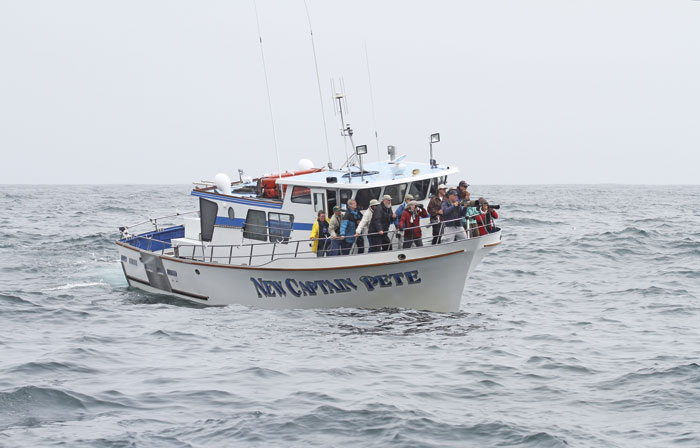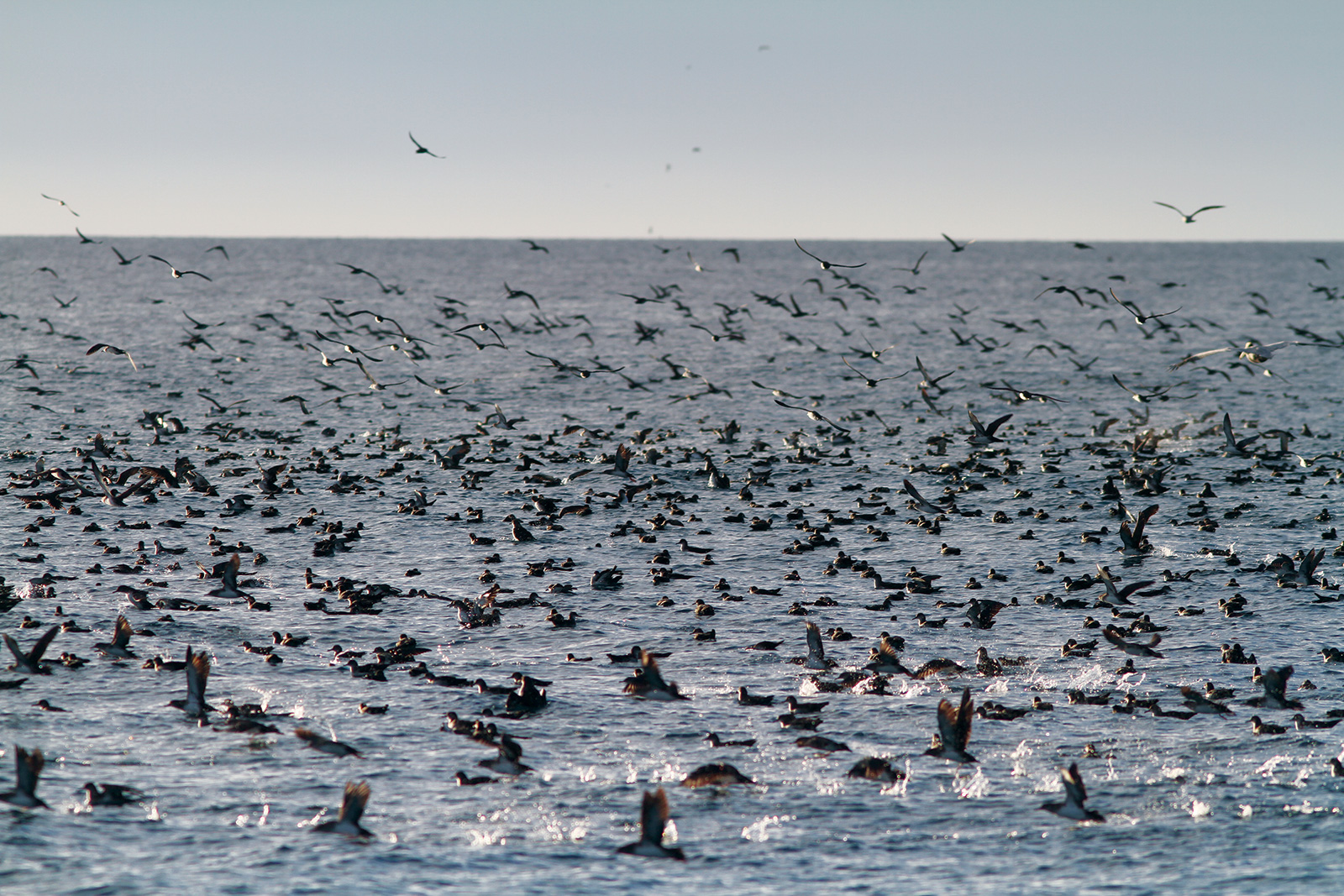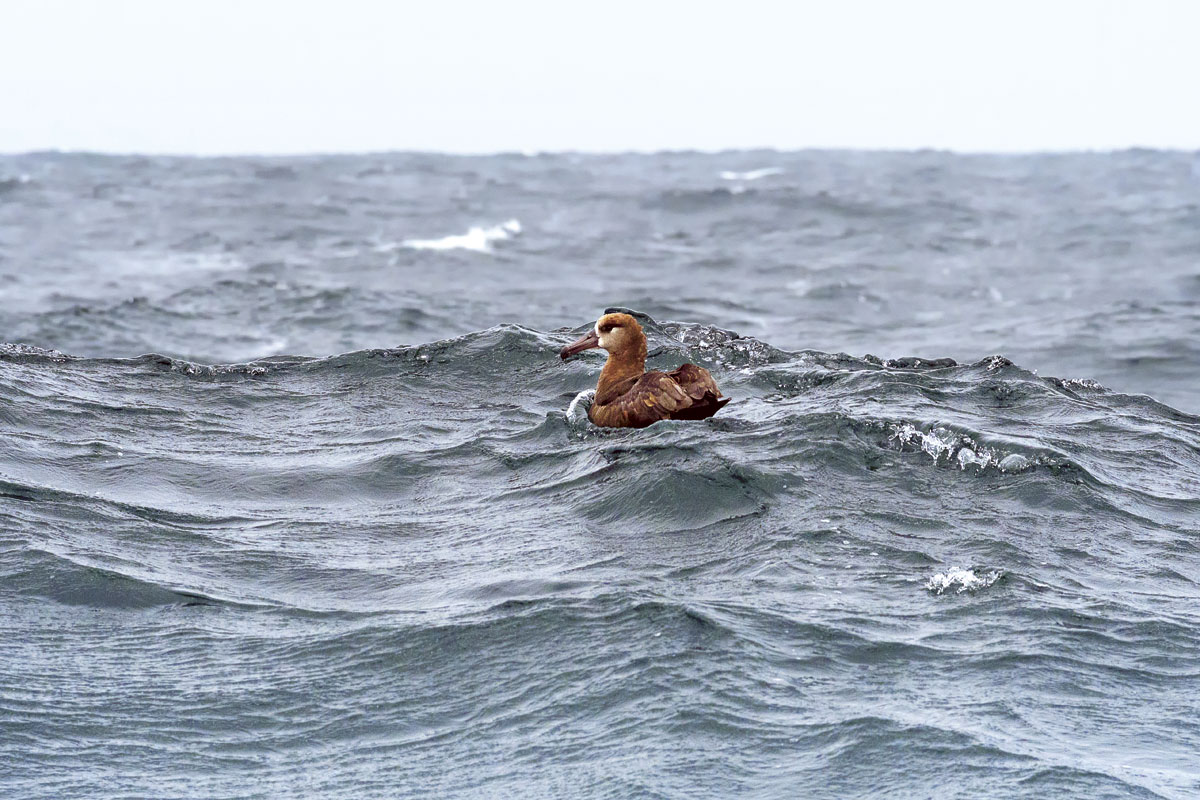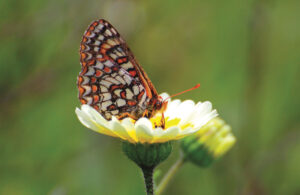We have arrived. Twenty miles offshore, the shallow plain 350 feet beneath our boat ends in a cliff. If we could get a fish’s view of the seascape below us, we’d see a 1,500-foot drop-off at the continental break. For an underwater climber, it would be like scaling two Golden Gate Bridges stacked on top of each other. There are saw-toothed gullies and submarine canyons, the equivalent of an underwater Yosemite or even parts of the Grand Canyon. A pair of ancient volcanoes—the Gumdrop and Pioneer seamounts—rise from the seafloor southwest of the Golden Gate, and rival in size their terrestrial neighbors Mount Diablo and Mount Hamilton. But from the surface, we can’t see any of it.
Underwater cliffs and canyons like these are where Northern California’s coast comes to life. Each spring a strengthening California Current beats against such cliffs, driving nutrients from below toward the sunlit surface and fueling one of the most biologically productive ocean zones in the world. Feeding on the nutrients, microscopic marine plants called phytoplankton multiply wildly, forming what is known as a bloom, and become the basis of a food web that fuels schools of forage fish like anchovies and sardines. There are also squid and swarms of krill, as well as whales, sea lions, porpoises, and sharks, among others. The fish also draw some of the least understood but most threatened avian species on the planet.
Pelagic birds from all over the world migrate to this stretch of the California coast each summer and fall to partake in the California Current’s feast. Dozens of species of seabirds, from albatrosses to shearwaters, murres to murrelets, guillemots, puffins, auklets, storm-petrels, and gulls and terns, migrate from far-flung breeding islands and elsewhere across thousands of miles of open ocean to reach California waters.
We don’t know much about pelagic birds, which live on the open ocean. Their life cycles play out far from easy observation. Tufted puffins, those clownish-beaked auks, for example, nest along inaccessible sea cliffs from Northern California to Alaska. Where they go in winter, though, when they seem to all but disappear into the central North Pacific, is anyone’s guess.
Once in California waters the birds remain in perpetual search of food; a section of ocean may be rich with life, but it’s patchy and ephemeral, changing as the wind, waves, and currents move. “If you think about trying to find your breakfast, lunch, and dinner in a habitat that’s a flat expanse of blue, that’s pretty challenging,” says Hannah Nevins, director of the American Bird Conservancy’s seabird program.
Another species is drawn to the seasonal gatherings: humans, and in this case, birders like us. Clinging to a rocking 53-foot Hoquiam fishing vessel, solid ground a faint smudge in the distance, and the unrelenting sun overhead, we’ve come to see species that are rarely sighted on the mainland. For many it’s a “once in a lifetime” opportunity to glimpse rare seabirds from the Southern Hemisphere. Out here, in the pelagic zone, there are still chances to break birding records. Braced against the railings of the fishing boat, several dozen bundled-up enthusiasts, binoculars readied, wait for a flash of wing or an oncoming swell to lift bobbing bodies into view in the gray-blue water. It doesn’t take long for a cry to rise above the wind.
“SKUA! Skua! Going right at one o’clock!” projects Alvaro Jaramillo, our guide, who has navigated us to this spot using the most recent satellite maps of ocean conditions and a sonar-operated depth finder device. “It’s big, it’s a bully—and it’s mean looking!” Jaramillo says. Adds a birder: “It’s really going after those other birds!” Barrel-chested with sporty, white-banded wings, the south polar skua races across the sky after a pink-footed shearwater to snatch away its meal—high drama on the high seas. “It’s the last frontier of birding,” Jaramillo says. “There are only a few select areas to go pelagic birding in North America and this is one of them.”

The trip had begun at dawn on an early October morning from Pillar Point Harbor in Half Moon Bay aboard the New Captain Pete, a compact fishing vessel with a deep rumbling motor piloted by Dennis Baxter, who after a career spent largely following birds to find sport fish is now learning to follow birds for a new and growing market—the pelagic birder.

But we’re relying on Jaramillo, a biologist with the San Francisco Bay Bird Observatory and author of several birding field guides, to locate the seabirds. Born in Chile, raised in Canada, and a resident of Half Moon Bay, Jaramillo considers himself tri-national and travels the world (much like the birds he observes) leading nature tour groups. He maintains an accessible approach to what can be an arguably intimidating and obsessive hobby. “I try to make it fun and friendly and not always geared to competitive and extreme birders,” he says. “Anybody who can handle a day out on a boat will see something different and better understand the ocean environment.”
To track down the birds, Jaramillo scans the latest satellite maps of chlorophyll levels and sea surface temperatures; he points to an area around the Half Moon Bay weather buoy where a warm blob of water is mixing with cold water. “We’re going to the interface because the interesting stuff happens there,” he says. “Think of water temperature as a different habitat. It might change whatever you’re seeing.”
The deckhand unties the ropes and we motor out along the twisty hairpins of jetties loaded with squawking brown pelicans and into a moderate 9-knot wind, enough to lift the seabirds off the ocean and into the skies where we can better see them.
Jaramillo points out a couple of common murres alongside the boat, black-and-white birds with a penguin-like appearance, and Captain Baxter comments that “anchovy birds” is the anglers’ name for them. “They’re a very useful tool,” he says. We cross a sun patch, and a harbor porpoise propels through the shimmering strip of water.
As we come to a reef, our depth finder begins to bleep and display a massive blob of red beneath our boat. It’s a school of fish. We see that brown pelicans and red-beaked Heermann’s gulls, nesters on primarily one small island in Mexico, have also found the spot. Then, Baxter heads starboard toward the open sea and explains we’re headed to a fishing area along a deep canyon colloquially called the “shrimp pots.” “There’s lots of landmarks out here,” he says. “They’re just underwater.”
As the waves pummel the boat, we see our first shearwaters—or rather Jaramillo does (from a distance they look like all other gray-white seabirds to the untrained eye). He uses the moment to break out the main categories of pelagic birds along the California coast. Shearwaters belong to the tubenoses, an order of seabirds also encompassing albatrosses and petrels, characterized by prominent tube-shaped nostrils on their upper beak. The tubes facilitate locating their prey by olfaction and finding their nests within vast nesting colonies. The mighty albatross, a surface feeder and fabled denizen of the high seas, navigates by smell to areas reeking with dimethyl sulfide, the “fishy” odor given off by phytoplankton. They often turn up alongside fishing boats looking for easy prey and may then get tangled or hooked on fishing gear, which become their own sort of albatross.
The auks, or alcids—including murres, murrelets, guillemots, puffins, and auklets—are the Northern Hemisphere’s equivalent of penguins, though they are unrelated, with crisp-looking black-and-white plumage and bulky bodies built to favor wing-propulsion underwater, although unlike penguins, they can fly. The piratical skuas, meanwhile, and their close cousins the jaegers, have well deserved bad-boy reputations, bullying the food from other birds by forcing them to drop or regurgitate their hard-sought meals. These large, acrobatic fliers truck in from nesting colonies in the polar regions in the late summer and fall to overwinter in our temperate climes. Finally, the sandpiper family, common shorebirds, is represented on the high seas by the phalaropes, petite and slender-necked with a bit of ruddy-red plumage and known for spinning in circles to stir food up to the surface.
And every now and then, a rarity will blow in—like the first and only spotting of a white-chinned petrel from South America, or a tropical storm-petrel, or the king of the sea, the endangered, short-tailed albatross, a breeder in Japan. “Those days become legendary,” Jaramillo says. “Those birds make history in birding. It’s a weird birding history. Nobody in the outside world cares.”

With the shoreline receding, we approach a scene of much flapping. “Feeding frenzy up ahead,” Jaramillo calls, as a variety of shearwaters come into view as well as a solitary rhinoceros auklet, a medium-size brown bird with a horn at the base of its bill (the horn’s function is unknown). “It’s too bad the ocean moves; it could be a lot easier,” Jaramillo remarks as birds disappear again within seconds behind the swell. “Also if the birds wore name tags,” one of the passengers quips. We pass near a sooty shearwater that’s desperately flapping its wings. “Look, he’s so full of food that he can’t take off!” Jaramillo says.
Some of the birders call out their wish lists—one person really wants to see a Manx shearwater, while a man who traveled here from Georgia is angling to glimpse a flesh-footed shearwater for the second time in his life (neither species appears that day). “If you focus enough, your mind will make it up,” Jaramillo cautions. “That’s why it’s always important to look at a bird with an open mind.” One woman, who’s keeping a life list of birds in San Mateo County, grumbles that we’ve crossed into the San Francisco county line, rendering all new sightings of bird species less consequential (to her). It’s news to me that the county lines matter this far past the shoreline.
At this point we’re about 14 miles south of the Farallon Islands, which rise like little peaks out of the water in the distance. Suddenly, a pod of Dall’s porpoises appear as shadows flanking the boat, and they ride its wake, emerging now and then to give off explosive breaths and show their white underbellies. Amazingly, we’re still seeing western gulls, though we haven’t been taking much notice because, well, what’s so special about a gull? “They’re very versatile—parking lots, 20 miles out at sea,” Jaramillo says about the range of habitats in which gulls can survive.
Of course, many seabirds have not fared well, thanks to humans. Their nesting grounds are often on islands where introduced mammals prey on the birds at their most defenseless life stages. Pink-footed shearwaters, listed as vulnerable by the International Union for the Conservation of Nature, breed entirely on three islands off the coast of Chile, including the famed Robinson Crusoe island. “It’s this remote, amazing little island with 700 people on it, but there are feral cats, rodents, and domestic dogs that prey upon the shearwaters,” Hannah Nevins says. “They go through this whole wide area of the ocean and when they come back to that one little spot on land, that’s where they’re most vulnerable.”
Albatrosses are among the worst off as a group—all 22 species are listed at some level of concern, from vulnerable to critically endangered. Their evolutionary survival strategy renders them vulnerable in a world hungry for seafood. Albatrosses live upwards of 50 years and produce a single chick at a time that can take more than a year to fledge. In the black-footed albatross’s case, the mates take turns collecting food for the chick. One stays put while the other travels for up to two weeks from the nesting site in the northern Hawaiian Islands to California fishing waters, then returns home with a slurry of concentrated fish oil, like a protein shake, in its stomach to regurgitate it into the hungry chick’s mouth.
As surface feeders, albatrosses are also prone to gulping down pieces of plastic that fill the guts of their chicks. And when a parent goes down in a longline fishing net, as happens with these bait-feeders, its death deals a heavy blow to the waiting chick and the species’ population. Nevins says fisheries have heeded requests to use new techniques that reduce the birds’ exposure to fishing lines, but it’s not mandatory.
Over the long term, sea level rise threatens albatrosses and other philopatric or site-faithful species. A 2015 U.S. Geological Survey study of Midway Atoll and the surrounding chain of islands—where three-quarters of the global breeding population of Laysan albatrosses and one-third of black-footed albatrosses nest—found that rising seas, as well as sudden flooding from waves and storms, could wipe out up to 90 percent of the nesting sites on some of the islands. In 2011, a powerful winter storm followed by a tsunami (caused by the earthquake that also destroyed the Fukushima Daiichi nuclear power plant in Japan) resulted in a “catastrophic nesting failure” for albatrosses on the atoll when 250,000 Laysan and 30,000 black-footed nests were lost. Conservation efforts for seabirds are also hampered by public indifference. “How do we get people to care about something they have never seen or will never see?” says Debi Shearwater, who pioneered and for 42 years has led pelagic birding tours off the California coast.
But there are some signs of hope. In California waters, a network of national marine sanctuaries largely protects the birds, and the birds are increasingly recognized as indicators of ocean health and healthy fish stocks. Pelagic tour boats not only help expose the public to these rarely observed species, they collect records of seabird sightings to share on eBird, the premier public online database tracking the worldwide distribution of bird species run by Cornell Lab of Ornithology and National Audubon Society. “Basically, every pelagic trip offshore in North America gets entered into eBird,” says eBird manager Brian Sullivan, who notes the data’s value to science and conservation efforts.

As we approach the edge of the continental shelf, our first black-footed albatross of the day soars overhead, dipping down into the trough of a wave and coming out the other side, using the rising air to propel itself forward. Albatrosses have astoundingly high glide ratios—on the order of 75 feet forward for every three-foot drop.
A large concentration of birds appears about a mile farther out and Jaramillo takes the bait, dramatizing the situation as we make a beeline to the spot. “We go into full hunter mode, like a bloodhound on a tracer. This is serious business we’re doing here.” We get a good look at some pink-footed shearwaters, which take off as the boat blows past, and a Buller’s shearwater, slimmer and longer than the others with bowed wings; visiting at this time of year from New Zealand, it’s a rarity.
“What’s that sticking out of the water?” Jaramillo asks, as the boat slows down near an area inexplicably empty of birds. “Oh, was that a blue? Look at the gray back—it’s a long back.” Over the next few minutes, we slowly realize what we’ve stumbled upon 20 miles from shore. A blue whale slides in and out of view, leaving in its wake a “footprint,” a smooth area of surface water, as it swims back down. Then a fin whale, with its perfectly sculpted dorsal fin, emerges and dives under our boat, coming back up on the other side. Humpbacks are everywhere, releasing their spouts like puffs of smoke. The captain turns off the engine. We watch, speechless, entranced.
Finally we pull away and it’s a straight shot back to shore. Along the way, my attention is drawn to something floating in the water that’s bedazzling in the late-afternoon sunshine, like a jewel, but it turns out to be a Mylar balloon, lost from some birthday party. We slow to pick it up. It becomes easy to see why seabirds, and other marine life, find trash so attractive, and how our lives are changing theirs, even when they are so far from sight.





